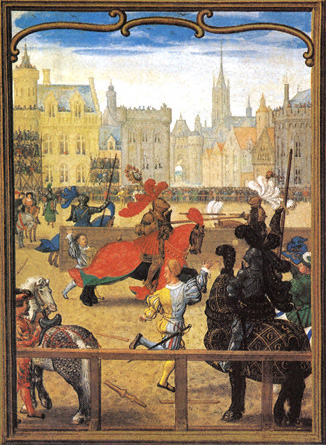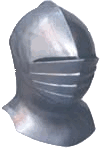![]()
Jousts
![]()

![]()
![]()
Jousts
![]()

![]()
By 1250 a new kind of combat in the tournament was becoming very popular. This combat was known as the joust. In a joust, two mounted knights armed with lances charged each other. In the earlier days, all of the knights used lances with sharp points, just like they did in battle. These jousts became known as "jousts of war". The primary goal of these jousts was for the knight to manipulate his lance so he could knock his opponent to the ground, but not kill him. This also was a way for the jouster to test his skill and courage. These jousts, even though not meant to kill anyone, were still very dangerous. By 1250, the "jousts of peace" were introduced. During "jousts of peace," the knights used lances with blunt ends or with a coronel fitted to the lance. The main idea was for the jouster to break his own lance against his opponent. Sometimes the knights would miss their target because the horses would not run straight or the two knights would collide. In the fifteenth century, a wooden barrier was added. This barrier was called the tilt. By adding the tilt, each knight could charge down one side and the barrier would keep them from colliding into each other. Before the tilt was introduced, knights could break their knees if passing too close to each other. Lord Henry in 1467 was even accused of having spikes on his horse armor when his opponent's horse collapsed after hitting his own horse. Some jousts, especially those of war, still did not use a barrier. Jousting was still quite popular after the medieval period, but began to decline by the seventeenth century.
![]()

Knights often wore ladies' "favors", generally a scarf, veil, or sleeve, when jousting. Sometimes a knight would appear with no heraldic markings. Knights met each other at combined speeds of 60 mph. Lances were measured, so no one knight had a longer lance. j |
![]()
![]()